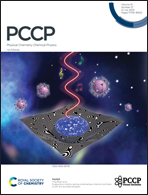Versatile transition metal monolayers with catalytic and superconducting properties: a computational study†
Abstract
Due to their abundant valence electrons and unique electronic properties, transition metals have garnered great interest in the search for novel materials displaying various properties, including superconductivity, catalysis and so on. XRu2 (X: V, Mn, Fe, etc.) compounds, which are isostructural to AlB2, were used as examples for which we performed extensive simulations to screen for superconductivity and possible potential catalytic activity. On this basis, we found that VRu2 could achieve a superconducting critical temperature (Tc) of about 13 K. Meanwhile, our simulations showed the lowest adsorption free energy of atomic hydrogen (ΔGH) on the (0 0 1) surface of VRu2 to be about 2 meV, indicating its almost zero free energy of hydrogen adsorption with excellent catalytic performance. In addition, the results suggested potential superconducting and catalytic properties of VXRu (X = Os, Fe). Our current results have shed light on possible applications of Ru-based AlB2-type intermetallic compounds and have presented a new strategy for further designing superconductors and catalysts based on transition metals.



 Please wait while we load your content...
Please wait while we load your content...